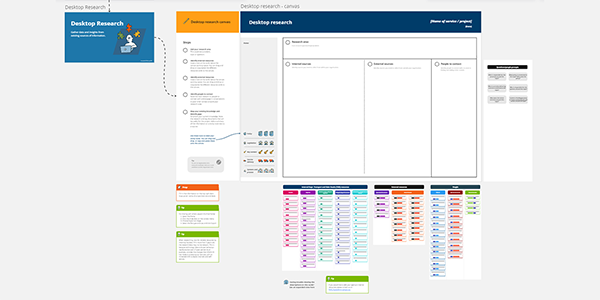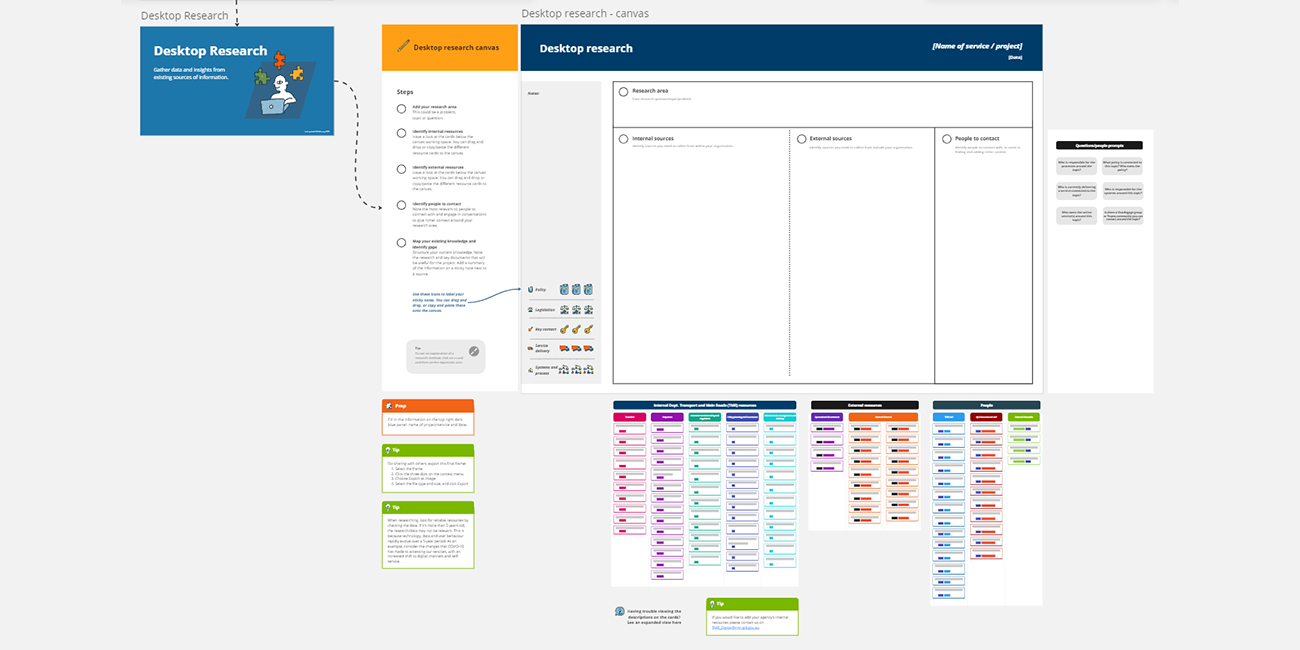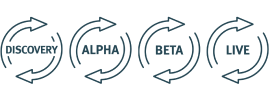Desktop research
Desktop research (also known as secondary research) involves the use of existing sources of information to gather data and insights on a topic of interest. This type of research relies on information that has already been collected and published by others, such as academic articles, government reports, market research studies or existing project documentation. It is often used to gather background information, support primary research, or to inform decision-making processes.
Desktop research is an important early step, to make sure you’re using your time and resources efficiently and not repeating something that has already been done. It should be the starting point of any research, to avoid reinventing the wheel.
For most benefit, desktop research should be done early in the Discovery phase. It can also be revisited during the other stages of the design process (Alpha, Beta, Live) as you further uncover useful information as the project develops.

Outcomes
- An overview of relevant resources around a specific research area
- A basis for developing hypotheses and research questions
- A list of key people that can contribute their expertise or knowledge
- Clarity on approaches that have worked or failed in the past
- Identification of research gaps or areas for future exploration
- Insights that can be used to inform decision-making
- A deeper understanding of a topic, including its history, current state, and future prospects
What you need
| Remote | In-person |
|---|---|
|
|
Instructions
Other plays to complete
Before starting desktop research, we recommend that you have completed these plays:
With these completed artefacts, you will have a better idea of where you need to focus your research effort.
Define a research area
Start by identifying the general area you want to research. This could be a broad topic or a specific problem. A good starting point would be the problem that was defined in the problem definition play.
If you're undertaking desktop research for a specific project, think about the areas that might be relevant to explore. For example, has there been engagement with the relevant user group recently? Is there any data that would be beneficial to review before recruiting specific user groups for usability testing? Are there any teams I can speak to who are experts in the area?
Desktop research is mostly explorative, so keep an open mind and follow leads to other subjects that might be relevant.
Preliminary Desktop research
Internal and external sources
The sources of secondary research can be categorised as either internal or external.
'Internal sources' refers to information that is generated or collected by the department or agency you work for. This might be project documentation, policies, user survey results, user data reporting, annual reports, and strategies, Internal sources can provide you with insights into how things operate currently, what the existing policy and legislative environment is and uncover any strengths or opportunities. This type of research can be useful in identifying areas for improvement and developing effective strategies to address those areas.
'External sources' are sources of information that are generated outside of the organisation. These can include government reports, legislation, existing data sets, market research studies, academic publications, and industry publications. External sources can provide you with an overview of the market and industry trends, competitive analysis, and user behaviours. This type of research is useful for identifying opportunities, as well as understanding the broader context in which the department operates.
Overall, both internal and external sources of secondary research are important for gaining a comprehensive understanding of the research topic.
Documenting the progress
As you sift through different sources, copy and paste relevant information into the miro template or spreadsheet template provided depending on what tool you prefer. Additionally, document or bookmark web pages for future reference.
Evaluate the information you find to make sure it's reliable and credible. Check the author, source, and date of publication. Look for biases or conflicting information. Use your critical thinking skills to determine whether the information is accurate and trustworthy.
Work with the Miro board or Microsoft Excel document as a guide for notetaking and adding insights as you go. Once you start identifying relevant resources, actively use the Miro board or Microsoft Excel document to help track your research and provide a visual overview of information gaps that your project needs to address.
Tip
When researching, look for reliable resources by checking the date. If it’s more than 5 years old, the research/data may not be relevant. This is because technology, data and user behaviour rapidly evolve over a 5-year period. As an example, consider the changes that COVID-19 has made to accessing our services, with an increased shift to digital channels and self-service.
Guiding principles for desktop research
We have created some guiding principles for desktop research within TMR. These principles are a guide of how to methodically search for and gather relevant insights. The key thing here is to derive from existing resources, not reinvent the wheel.
- Start with relevant research, data and information within your organisation
- Explore other research, data and information outside of your organisation
- Connect with the right people to give richer context
- Map your existing knowledge and identify gaps
Invite your participants
Participants in this session should be made up of the project team and any subject matter experts relevant to the project. This might include a project manager (PM), project officer, designer, business analyst, communications officer, solution architect, or developer. Aim for including a range of people to form a multi-disciplinary team. You’ll want to make sure when you send an invite for the session, that you clearly explain the goal, how long it’ll take, and why people’s participation will be beneficial.
It’s important to give enough notice to ensure participants have free time to come along to the session. Aim to send invitations about 2 weeks in advance.
You can also attach the play for people to look at ahead of time.
Calendar meeting request for desktop research
Subject:
You're invited to help conduct desktop research for [project name]
Meeting description:
Dear [Team Name/Participant Name],
I hope this email finds you well.
As part of our ongoing work for [Project Name], we are organising a desktop research activity to explore secondary data sources related to our project. This activity will involve gathering valuable content from various sources to enhance our understanding of the topic and be a basis for our work.
In this session we plan to uncover relevant information that can contribute to our project's success. Desktop research involves utilising existing resources such as articles, reports, and publications to gather insights and support our decision-making process.
During the session, we will explore a range of secondary data sources to extract key findings and relevant data points. By conducting this research, we aim to complement our existing knowledge and gain a comprehensive understanding of the topic at hand. No specific preparation is required beforehand.
Your expertise and insights are crucial to the success of this desktop research activity. We appreciate your participation and look forward to the valuable contributions you will bring to the table.
At [Project Name], we strive to create an inclusive environment where everyone's perspectives are valued. If there are any specific accommodations or considerations that would make your participation more comfortable, please let us know, and we will make the necessary arrangements.
Thank you for your ongoing support and dedication to [Project Name]. Should you have any questions or require further information, please feel free to reach out to me.
Kind Regards,
[Facilitator Name]
1. Add your research area
Note the research area (defined previously) as your starting point. This could be a problem, topic or question.
2. Identify internal resources
Start with relevant and up-to-date existing research, data and other information within your organisation
Before you conduct more research you should understand the data and information your organisation already holds. Collect a list of potentially promising internal sources around your research area.
Explore internal sources such as:
- Your organisation’s intranet
- Organisational libraries
- Check existing user research and insights
- Review existing user research
- Relevant user information
- Annual reports or strategic plans
Check out our templates (Miro board or excel document), for a more extensive list of internal sources to explore.
3. Identify external resources
Explore existing research, data and other information outside of your organisation.
External desktop research refers to information gathered from sources outside of your organisation, including academic journals, public libraries, open data databases, internet searches, and well-respected organisations' white papers. It is important to use information sources which are reputable and relevant to the project.
Please consider where the best information directly related to your field is located. This includes:
- Industry relevant authorities and governing bodies
- Project relevant authorities and governing bodies
- Organisations who have conducted related projects
- External existing research or information
State and National data and information sources include:
- Queensland Government open data portal (each state has its own open data portal)
- QLD Government legislation
- Get Involved WoG (Whole of Government) engagement
- Ministerial decisions
- Australian Bureau of Statistics (ABS)
- Australian open government data
- National Library of Australia
- National Archives of Australia
- CSIRO (Commonwealth Scientific and Industrial Research Organisation)
External research sources to explore include:
- Google Scholar
- ACM digital library
- Journal of Usability Studies (JUS)
- Gartner research access (all TMR employees have a paid membership)
- JSTOR
- Science.gov
- Digital Commons Network
Check out our templates (Miro board or Excel document), for a more extensive list of external sources to explore.
4. Identify people to contact
Connect with the right people to give richer context
Get expert advice
It is important to connect with people and encourage conversations to give richer context around your research area. You will be surprised how much guidance and knowledge you can gain from engaging with the right people. People to contact might include:
- Internal policy owners
- Internal experts or coordinators who can help find existing research
- Staff with many years of corporate knowledge around organisational history
- Relevant teams such as User Insights or Customer Experience
- IT support teams
- Organisations that have a library service
Tap into communities and groups
Tap Into communities and interest groups, including:
- Communities of practice, such as customer research community of practice or user experience community
- Champion networks and Viva Engage communities
- Digital Profession
Questions to help you get started
For some ideas of who to reach out to, ask yourself the following questions:
- What policy is connected to this topic? Who owns the policy?
- Who is currently delivering a service connected to the topic?
- Who is responsible for the systems around this topic?
- Who is responsible for the processes around the topic?
- Who owns the online service(s) around this topic?
- Is there a Yammer group or Teams community you can contact around the topic?
5. Map your existing knowledge and identify gaps
Structure your current knowledge
Using your Miro board or Microsoft Excel template, note the research and key documents that will be useful for the project.
Identify any:
- Insights to support your research area and project objectives.
- People you need to include in your project team or stakeholders you need to consult.
- Gaps that exist and what information you might need. This is likely to be the space where you will need to undertake primary research for the project.
Tip
Use the Miro board template or Microsoft Excel template to take notes as you read to draw out key insights and page numbers.
Run our stakeholder mapping play, if you haven’t already.
Plan your own primary research using the user research planning play.
Now that you have compiled knowledge, resources and contacts, you can refer back to these as needed throughout the project. Any user data may be particularly helpful for recruiting the right participants if you’re planning to conduct usability testing.
Keep an archive of resources and documents in the Miro board or Microsoft Excel document. Even though not all of the research will be relevant in the early stages of the project, you can refer back and reach out to teams as needed as the work evolves.
Resources
See below for a collection of templates and other pages which will help you run this play. These resources are also linked in the play instructions.
Subject:
You're invited to help conduct desktop research for [project name]
Meeting description:
Dear [Team Name/Participant Name],
I hope this email finds you well.
As part of our ongoing work for [project name], we are organising a desktop research activity to explore secondary data sources related to our project. This activity will involve gathering valuable content from various sources to enhance our understanding of the topic and be a basis for our work.
In this session, we plan to uncover relevant information that can contribute to our project's success. Desktop research involves utilising existing resources such as articles, reports, and publications to gather insights and support our decision-making process.
During the session, we will explore a range of secondary data sources to extract key findings and relevant data points. By conducting this research, we aim to complement our existing knowledge and gain a comprehensive understanding of the topic at hand. No specific preparation is required beforehand.
Your expertise and insights are crucial to the success of this desktop research activity. We appreciate your participation and look forward to the valuable contributions you will bring to the table.
At [project name], we strive to create an inclusive environment where everyone's perspectives are valued. If there are any specific accommodations or considerations that would make your participation more comfortable, please let us know, and we will make the necessary arrangements.
Thank you for your ongoing support and dedication to [project name]. Should you have any questions or require further information, please feel free to reach out to me.
Kind Regards,
[Facilitator Name]

